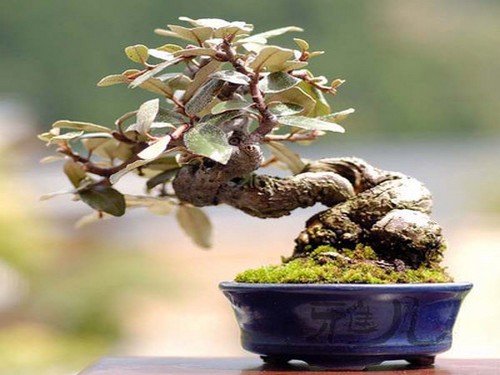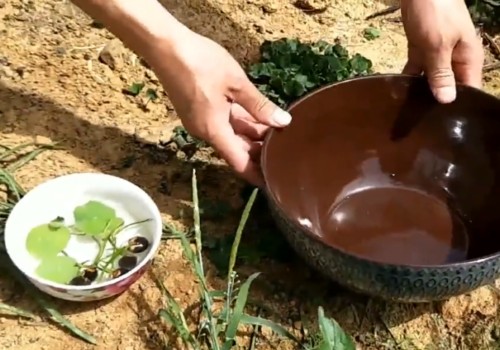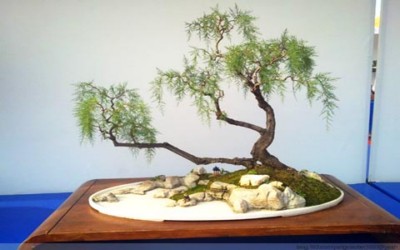Maintenance and management method of Elaeagnus angustifolia bonsai
Potted Elaeagnus angustifolia only blooms but does not bear fruit, which is closely related to the potted time, variety, nutrition and management methods. Elaeagnus is easy to bear fruit in the mountains because it grows for a long time and has a developed root system, which can absorb nutrients from a large amount of soil. The soil planted in the pot is limited, and it must be grown for several years. After the root system is developed, it is possible to bear fruit under the condition of sufficient fertilizer and good light and ventilation.

Different varieties of Elaeagnus chinensis have different results. For example, compared with Elaeagnus macrophylla, Elaeagnus microphylla is difficult to bear fruit, while Elaeagnus macrophylla can flower clusters all over the tree. In order to achieve high fruit setting rate after flowering, decomposed farm manure should be applied every 10 days in the growth period, so that fruit setting can reach more than 40% of flowering. Early spring can see full trees such as red jade, crystal clear, very lovely red fruit. Elaeagnus is easy to bear fruit tree species, as long as attention to management, apply sufficient fertilizer, fruitful year after year or can do it.
Elaeagnus amurensis likes warm, humid and sunny environment, tolerance to semi-shade, drought, slightly water and humidity. The bonsai growing season can be placed outdoors in a place with sufficient light and good ventilation. Summer high temperature when appropriate shade, to avoid the sun exposure, watering master "see dry see wet", often spray water to plants, to increase air humidity, so that leaf color moist. During the growth period, a decomposed thin liquid fertilizer or a compound fertilizer based on phosphorus and potassium fertilizer should be applied every 10 days or so. The nitrogen content in the fertilizer should not be too much, otherwise the plant branches and leaves are luxuriant, but the flowering is rare.
The cold-resistant ability of Elaeagnus chinensis is not too strong. In winter, the flowerpot can be buried outdoors in a sunny place, or in a cold room with sufficient light and no lower than 0℃. In winter, watering can be reduced appropriately, but the pot soil cannot be too dry. Every 3 years for a pot, it is appropriate in loose fertile, rich in humus soil growth better, available garden soil, humus soil, mixed with a small amount of decomposed cake fertilizer and other organic fertilizer mixed preparation, and put a few pieces of broken bone and other phosphorus and potassium fertilizer as base fertilizer.
The ability of terminal buds of Elaeagnus chinensis is weak, but the germination ability of lateral branches is very strong, and its fruits are mostly born in the leaf axils of the branches of the next year. Therefore, it is necessary to cut again around the autumn equinox every year, apply more phosphorus and potassium fertilizer after germination, and control water appropriately to avoid excessive growth of new buds and promote short and dense internodes, so as to maintain the sparse tree shape. A small pruning is carried out around the beginning of spring in the second year, and the long branches are cut short. After germination, pay attention to picking.
During the growth period, it is also necessary to properly pick the core, remove the buds on the trunk in time, and cut off the long branches or other branches and new buds that affect the tree shape to avoid consuming too much nutrients and affecting the growth. Autumn bud germination attention to control watering, more phosphorus and potassium fertilizer, in order to promote flower bud differentiation, so that more flowers, more fruit. If the tree is weak during maintenance, the flowers can be removed, and the fruit should not be produced, so that the plant can flourish for one year to promote the restoration of tree vigor.
Specific conservation management methods:
Place: Elaeagnus should be placed in a place with sufficient light and air circulation.
Summer does not need shade, winter is cold-resistant, can be placed outdoors, shallow basin can be buried in the soil for winter.
Watering: Elaeagnus is wet and drought-resistant, so watering should be sufficient, but only when the pot soil is dry, watering is thorough, not often the pot soil is wet, so easy to make the root rot, unfavorable growth. Basin soil should see dry see wet, in order to flourish, grow well.
Fertilization: apply thin organic fertilizer once every month in spring, stop applying during plum rains, and apply root fertilizer with potassium dihydrogen phosphate before fruit hanging.
Autumn every half a month to apply once, to be mainly phosphorus and potassium, such as bone meal, calcium superphosphate, etc., to promote flowering fruit Sheng. Apply decomposed cake crumbs once in winter as base fertilizer.
Pruning: Elaeagnus germination shoot ability is strong, in the appropriate environment, water and fertilizer conditions, easy to shoot long branches, disturb the tree beauty, should be pruned in time, and can pick buds to shoot to control growth.
Turn the pot: turn it every 3 to 4 years, preferably in early spring or after autumn.
The hardened old soil should be replaced by 13~12, replaced by loose fertile culture soil, and a layer of vermiculite or coarse sand should be placed on the bottom B B of the basin to facilitate drainage.
Pest control: Elaeagnus angustifolia has strong disease resistance, occasionally red spider, scale insect and other pests, can spray 1000~2000 times 40% dimethoate emulsion to control red spider, scale insect is usually manually scrubbed, can also be used dimethoate emulsion control. Spraying should be carried out under strong noon light, pay attention to spraying the back of branches and leaves.
Time: 2019-06-02 Click:
- Prev

Which flowerpot is the best to grow lotus in bowl?
Pot culture bowl lotus is both ornamental and practical, if we can raise some ornamental fish in it, the basin will be more vibrant and interesting. But if you want it to grow vigorously and bloom more and more brightly, the planting method should also be correct. First of all, we need to be suitable on the matching basin.
- Next

Maintenance methods of strange willow bonsai
Tamarix, alias weeping willow, Xihe willow, Xihu willow, red willow, Yin willow; Asclepiaceae, Tamarix deciduous small trees. The tender branches and leaves of Tamarix are traditional Chinese medicine. It is produced all over China. Rare or dry use. The branches of Tamarix are thin and soft, their posture is whirling, and they bloom like Polygonum polygonum, which is quite beautiful. Often planted for ornamental planting in the garden
Related
- Fuxing push coffee new agricultural production and marketing class: lack of small-scale processing plants
- Jujube rice field leisure farm deep ploughing Yilan for five years to create a space for organic food and play
- Nongyu Farm-A trial of organic papaya for brave women with advanced technology
- Four points for attention in the prevention and control of diseases and insect pests of edible fungi
- How to add nutrient solution to Edible Fungi
- Is there any good way to control edible fungus mites?
- Open Inoculation Technology of Edible Fungi
- Is there any clever way to use fertilizer for edible fungus in winter?
- What agents are used to kill the pathogens of edible fungi in the mushroom shed?
- Rapid drying of Edible Fungi

